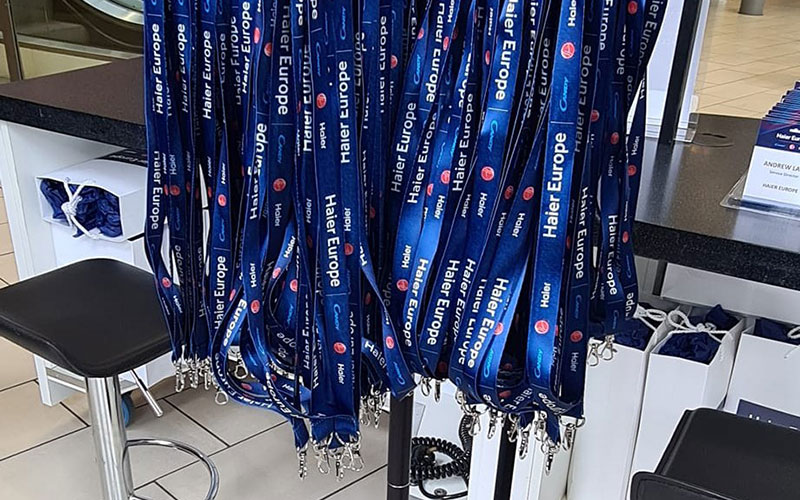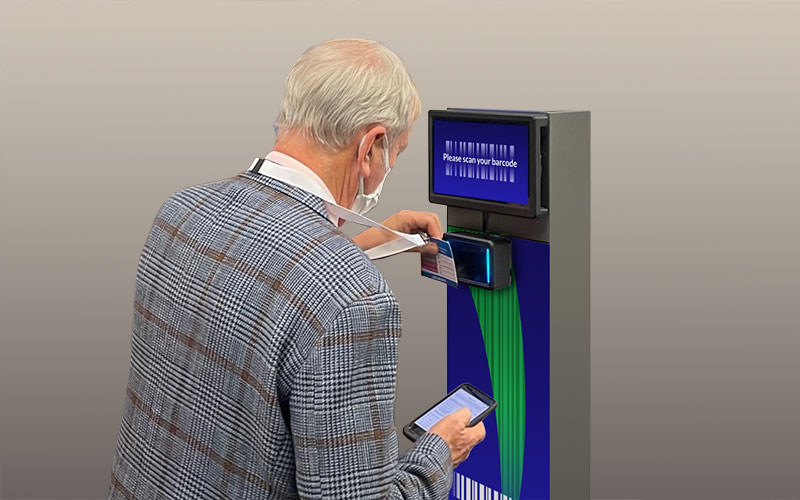Top tips for your onsite registration area
It's easy to get caught out on your first event: you've dealt with all the problems – it's all going well and then you get onsite, and people start asking questions that you didn't realise you needed to think about. We've put together years of experience here to help you have the smoothest of set-ups for the registration area. (We'll leave other suppliers to advise you on the other areas.)

1. Timing.
Yes, it's stunningly obvious when you think about it but make sure that you have booked the registration area at the venue for long enough before the event starts. Your badging supplier needs time to get everything set up and tested. If time is tight, check whether your badging supplier will be able to cope.

2. Signage
How easy will it be to find your registration area? To answer this question, try walking from the most likely arrival points in the venue to your registration area. How easy will it be for your attendees to get from one to the other without standing around wondering where to go next?
If you need signage will the venue provide it, or do you have to organise it yourself? If the venue will provide it, how much will it cost?

3. The door
It might seem obvious, but you need to think about the door. Is there just one door to your registration area? If there is, can it be locked? If it can, does it mean that your attendees are likely to be standing outside in the rain or the sun until you're ready to open?
It may be that the registration area is within a convention centre and that the doors have to remain open. If that's the case, you'll need to find a way to keep your attendees out of the registration area until you're ready. Crowd barriers (often in the form of posts and ropes) are usually sufficient and can be hired easily.

4. When will registration open?
Working out when registration is to open isn't always a simple question.
If you're organising an exhibition, you might want to get people badged ahead of the show opening. That way your exhibitors see a satisfying number of visitors flooding into the exhibition hall as soon as it opens.
If you're planning a conference, you'll probably want to open registration well ahead of the first sessions. If you do that you increase the chances that everybody will be able to collect their badge in time to find their first session. Equally important, they'll have time for networking over coffee.
Once you've decided the opening time for registration you need to make sure you've told everybody on the event team. Yes, it's obvious, but organisers have been known to forget to tell the people that need to know!

5. What sort of badging?
Whatever type of event you're organising, there are options for badging. From physical badges being mailed out in advance, and print-at-home badges, to e-badges and geolocation enabled barcodes for quick and simple entry.
If you're badging onsite, will you need to explore what type of badging systems are available to you.
There is plenty of choice from a simple paper badge in a plastic wallet, through to a premium credit card style badge. There are also the plastic free options in the form of peel and stick badges, which come in a variety of sizes and thicknesses depending on how long the badges are needed for.
You may want to opt for a print-at-home solution, so your attendees are responsible for printing and bringing their badge. Remember though, not everyone may have access to a printer or even a colour printer.
Then if you really wanted to go ‘all-tech’ there could be options to have a ‘virtual badge’ which are normally contained within an Event App.

6. How is registration to be arranged?
This depends on how you're working. If you're sending out badges in advance, you'll only need to provide a minimal badge printing facility. You'll always have people who have forgotten or lost their badges.
If you're pre-printing badges and laying them out in trays on the registration desks, they must be in alphabetical order. Again, if you have a couple of hundred people arriving, you can probably manage with having the badges laid out on one table.
If there are several hundred, you'll need to have multiple desks, divided by letters of the alphabet. These need to be in alphabetical order from left to right as your attendees look at them. You'll need signage identifying the desk for surnames beginning A-D, for example.
Now look at the desks from the point of view of your staff. The badges need to be laid out in alphabetical order from their left to their right so they're easy to find. The desks need to be separated so that you don't find the first row of As being mixed up with the last letter on the next desk.
It can be very useful to have a gap between desks so that staff can get out from behind the desks easily.
Where you have opted for an e-badge or some form of barcode entry you will need to consider whether you want these stations manned or unmanned. You will also need to consider where you will send the attendees who have forgotten their barcode, or who were unable to print their print-at-home badge for whatever reason.
If you've never organised a meeting of this sort before, talk to the badging company and listen to their advice. All of the above require you to really consider the space you need for your registration area.

7. CPD certificates
If you're organising the type of conference for which delegates earn CPD credits, you might want to be able to convert a badging station into a certificate issuing station. This should be easy to do around lunchtime on day one. But if you want to do this, make sure your badging supplier knows well in advance.

8. Conference packs, goodie bags, lanyards
This is a good time to work out how you're going to organise the materials that need to be given to registrants.
The golden rule is to make sure that you have enough of whatever you're giving out unpacked and in place the day before it's needed. Conference packs and goodie bags need to be stacked in such a way as to make sure they don't spill across the floor. Lanyards are best hung on hooks if possible: they have a habit of getting tied in knots.
If the contents of the goodie bags have a value, it's worth getting your registration supplier to provide a checking system. This just means using a scanner to scan the barcode on each badge. The scan is recorded on the registration system so that if that person comes to get another goodie bag, the system can tell the operator that they've already had one.

9. Controlling the doors to the event
Assuming that you want to control who goes into your event, you're going to need one or more choke points – spaces that attendees can only pass through one at a time. Obviously if it's a big event you'll need several of these. They don't need to be as obvious as a turnstile – posts and ropes will do the job – but one way or another you need to give the staff on the door a fighting chance of making sure that everybody has a badge.
If you want to scan people into the event, you'll need stewards with scanners unless you use technology like our ScanPods. These help to cut down on the number of staff you'll need as attendees simply scan their badge to gain entry.
There's then the question of who will deal with anybody who doesn't have a badge. You might want to have security staff available to deal with gate crashers. Or make sure you have planned to have a registration and badge printing station available for walk-ins.

10. Staffing
Work out how many staff you'll need on the doors and in the registration area. It's likely that you'll need more first thing because that's probably when most of your attendees will arrive. So, you'll need to work out what time you can release some of the staff for other duties.
You'll also have to decide where the staff are to come from. Will they be your own people, from the venue or from an agency? Again, your badging provider will be able to advise on this and probably supply staff as well.
It's worth deciding early on whether you want a uniform appearance. You'll probably be OK asking that all temporary staff be dressed in, say, white shirt and black trousers or skirts. That shouldn't incur a cost to you. Anything more than that might involve cost unless whoever supplies them provides uniforms.
Make sure you look after all of the people working on your event – whether registration staff, stewards or the various other people who will be onsite. There are two main aspects to think about: shifts and food.
You could demand that stewards, for example, are on duty from 8 in the morning until the event closes at 5 in the afternoon but this would be unreasonable. If it's a multi-day event, you might find a lot of absences after the first day. So be sure to schedule in breaks for everybody, including you.
If you're not providing food and drink, this needs to be made clear well in advance so that staff can bring their own. You'll also need to provide an area where they can sit and eat in comfort, out of sight of your attendees.

11. Supervisors
All of that is important but you also need to make sure that you have a calm, reliable person supervising the whole registration area. On a big event, this job can get very stressful, so you'll need the right person in place. If you have a lot of registration desks, life will be much easier if you have a separate person supervising the registration team. This person has to be willing to do whatever is necessary to get your attendees badged and into your event as quickly as possible. The last thing you need is somebody saying that they work for the badging company and helping to sort out event packs isn't part of their job!

12. How are you going to organise lines/queues?
If you're new to organising this one can take you by surprise. You have a choice between what we refer to as the supermarket option or the airport option.
In the supermarket option, you'll have multiple queues. This works well if badges are pre-printed and laid out alphabetically but it's less successful if you're printing on demand.
In the airport option you'll have one queue and the person at the head of the queue goes to the next badge printing station that's available. If you go for this option, make sure there's enough space for the queue. On big events it might be a good idea to have a steward at the head of the queue directing people to the next available printing point.

13. What about VIPs?
VIPs come in different guises so the arrangements you need will vary.
If you've got a famous person arriving to declare your event open, it's probably enough to have a senior person from within your organisation at the entrance to meet them when they arrive.
Otherwise, you might want to have separate registration areas for speakers, hosted buyers, exhibitors and so on.
If you want individuals to be easily identifiable, think about giving them different badges – a colour flash along one edge of the badge is usually sufficient. To provide even more help in identifying them, maybe they can have a different coloured lanyard.
As with so much in planning your registration area, this is a subject to discuss with your badging supplier. They have the great advantage of having done it before, probably many times.

14. Wi-Fi
It's tempting to read that the venue has superfast Internet connections and assume that it will meet your needs. But you need to understand exactly what that means. Is your registration system dependent on an Internet connection? Will it still have access at the first coffee break when all your delegates are going online?
If you're organising a big event, you might need multiple networks. That way you can have different groups on different networks so that the teams who really need access to make sure the event runs smoothly never get shut down because so many people are logging in.
For registration, check with your badging company. Do their solutions work offline as well as on the Wi-Fi? For example, ScanPods use a wireless connection to record an individual's attendance. If the connection drops for some reason, the ScanPod itself will store the data. As soon as the connection is re-established, it'll upload all the data it has stored. This also means the drop in connection does not affect reporting of attendance.

15. Communication
Every event organiser used to use 2-way radios. These days, many rely on WhatsApp and group text on mobile phones instead. It's a question of working out what works best for you and your teams.
Whatever system you use, it's vital that the people on the main doors can contact you quickly and easily if there's a problem.
In communicating with the attendees, you've probably been told that you have to have an all-singing, all-dancing App. That may be true in your case but think it through and make sure it's right for you and your attendees.
Beware of pushing out too much information to attendees. If their phones are constantly pinging with new push notifications, they might decide that the app is annoying and switch it off. So, make sure the content is relevant, useful and valuable enough to encourage them to install it as they arrive.

16. Security
The level of security you need on the registration area will vary, depending on the nature of your event. You'll know if you're likely to attract the attention of protesters, for example.
But you also need to remember that the registration area could have multiple computers and monitors in place. The badging company's insurance might stipulate that these are your responsibility while they're onsite. If that's the case, you might want to provide a room where they can be locked away safely.

17. Delivering and returning kit
If your badging company is providing onsite support, you won't have to worry about this. If you're handling all the onsite activities yourself, make sure that the equipment will arrive in good time before the event. Then make sure that somebody is responsible for packing the kit up and sending it back.
If you're in an overseas location, you'll need to find out how long it will take for the kit to clear Customs. The last thing you want is for all the badging computers to be in a Customs shed somewhere when your event opens.

And finally
Expect the unexpected. You need to think of everything that could go wrong and develop a contingency plan to deal with it. Then you need to make sure your team know about it.
But you'll still be surprised sometimes.
The secret, according to one very experienced event organiser who has dealt with multiple surprises in his time, is to be able to keep the people around you calm. Then work out as quickly as you can who is best placed to help and put them to work sorting out the problem.
Better still, he says, is to find the best people you can to do the jobs that need to be done on an event and then try to look as if you're in control. That way, somebody will already be dealing with the problem by the time you hear about it.
Talk all these options through with your badging supplier. They should be able to advise you on the best solution for you and may also have valuable knowledge of your chosen venue(s) and the registration layouts that may work best.